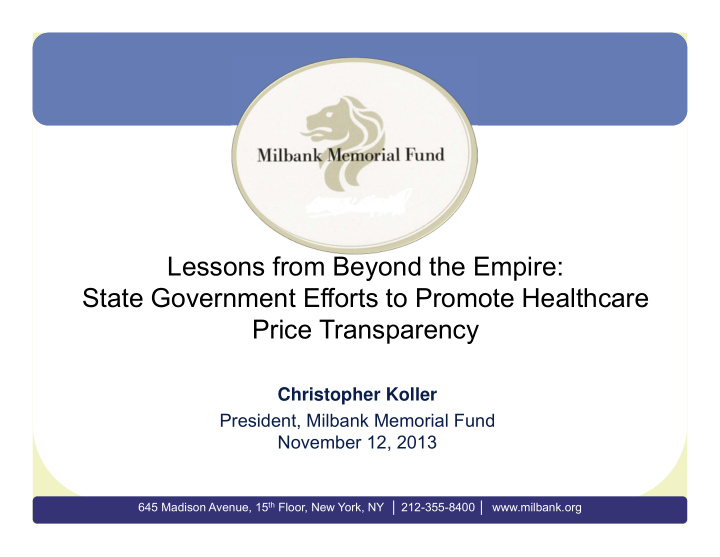



Lessons from Beyond the Empire: State Government Efforts to Promote Healthcare Price Transparency Christopher Koller President, Milbank Memorial Fund November 12, 2013 645 Madison Avenue, 15 th Floor, New York, NY │ 212-355-8400 │ www.milbank.org
Overview of Presentation • Milbank Memorial Fund • Defining the Public Interest in the Issue • Examples of Price Transparency Efforts in RI and elsewhere • Lessons Learned │ Slide 2 11/18/2013
What do we mean by “Price” • What the purchaser ( usually third party) pays. • Can be charges (unrelated to cost) or discounted (huge) │ Slide 3 11/18/2013
Stakeholders’ interests in price transparency Stakeholder Interest Uninsured and Out of -Avoid sticker price shock Network Consumer -Protection from bankruptcy Insured Consumer -Information for rational choices. -Protection from price variation not based on quality Insurer and purchaser - Protection from market power (failure of private negotiations) Provider - Information for rational choices │ Slide 4 11/18/2013
Common State Actions - Mandated charge master Uninsured Consumer disclosure - Mandated discounts Insured -Maintenance of fee schedule Consumer databases with public access - Charge master analysis Insurer and - Fee schedule collection and analysis purchaser Provider - Mandated access to insurer information │ Slide 5 11/18/2013
1. Maintenance of Price Databases for Public Access Examples: Massachusetts, Minnesota, New Hampshire. Florida…among others Challenges: User accessibility (Patient language vs CPT language) Companion Quality Info Updates Resources and Competencies required Experience to date: No evidence of effectiveness – not a typical state skill Better done by carriers? │ Slide 6 11/18/2013
2. Charge Master Analysis • Examples: – (CMS), New York State, Fairhealth.org • Policy Goals: – Motivate outrage (Steven Brill) – Public Shaming • Outcomes: – (Useful, but part of a bigger strategy) │ Slide 7 11/18/2013
3. Fee Schedule Analysis • Goals: – Document and understand price variation in local markets: by hospital and payer – Evidence for subsequent policy • Process – State collection of data – Internal analysis – Stakeholder engagement – Publication • Examples: Massachusetts, RI, New Hampshire among others. │ Slide 8 11/18/2013
3. Fee Schedule Analysis Challenges: • Collecting Data • Risk adjustment • Naming names and dealing with blowback • Fear of unintended effects – Variation can also be reduced by raising lowest │ Slide 9 11/18/2013
Fee Schedule Analysis in RI • Focus on hospitals – Previous anecdotal evidence of variation – Cross subsidies of public payers? • Paid for by ACA Rate Review Funds • Collect all payer data • Third party contractor • Relative pricing, not insurer specific • Intense stakeholder process │ Slide 10 11/18/2013
Results – Inpatient Services Ratio of average risk adjusted per day rate to overall average Source:http://www.ohic.ri.gov/documents/Insurers/Reports%202/2012%20Rhode%20Island%20Hospital %20Payment%20Study/1_2012%20Rhode%20Island%20Hospital%20Payment%20Study%20Final.pdf │ Slide 11 11/18/2013
Fee Schedule Results in RI 1. Hospital outpatient is half the revenue and harder to analyze. 2. Public Scrutiny reduced monopoly pricing – Greater public accountability by hospitals 3. No comprehensive legislative action – What is a fair price? – Hospitals – public utility or private asset? 4. Some executive action – OHIC followed up with limits on rates of increase and contracting conditions – Similar actions by Medicaid │ Slide 12 11/18/2013
Lessons Learned 1. Have funds to do it right – Risk adjustment and all payer 2. Conduct public process to address concerns. 3. Relative price is fine 4. Be ready to deal with consequences – Leads to health services planning and policy questions on rate oversight – Rate oversight reduces inflationary concerns │ Slide 13 11/18/2013
4. Provider Access to Fees • Conflict – Incented providers who want access to fee information – Insurers who want fee information private; fear of price escalation. • Why the insurers will lose this battle – “Really?”: Indefensible position to the providers who they want to control costs – Medicaid and Medicare are publicly accessible – They are making more info available to consumers. │ Slide 14 11/18/2013
4. RI Provider Price Disclosure Bulletin In response to concerns of PCMH’s and at risk provider groups. OHIC issued q2 2013 (new) as bulletin Directs Health Insurers to disclose provider rates for requested services to primary care providers upon request of PCP Public interest to trump private contract Only for purposes of care coordination Limits on disclosure. http://www.ohic.ri.gov/documents/Insurers/AdoptedB ulletins/02_2013%201%20Price%20Transparency% 20Bulletin.pdf │ 15
4. Provider Disclosure • Status in RI – Enforcement is key: insurers can stonewall. • Lessons – Setting culture for insurers – Sophisticated providers will get claims and reverse engineer a price. – Information is not conclusive │ Slide 16 11/18/2013
Final reflections on state role in price transparency • Winning policy politically • Stay out of consumer disclosure – Ample evidence that consumer facing transactions are not core public skill • Do not oversell: necessary but not sufficient for delivery system transformation • Be prepared for consequences… │ Slide 17 11/18/2013
Be Prepared for What Happens When You Lift The Rock… │ Slide 18 11/18/2013
Be Prepared for Policy Discussion: How provider rates are determined is fundamentally conflicted (Public rate setting) (Negotiated rates) But That is the Place for Public Leadership │ Slide 19 11/18/2013
Recommend
More recommend